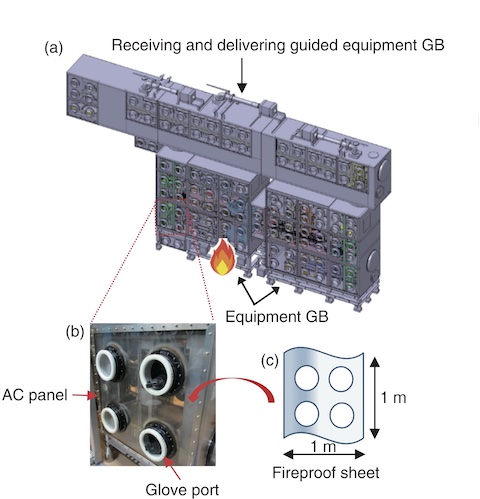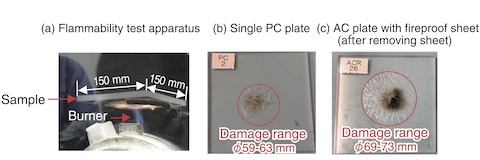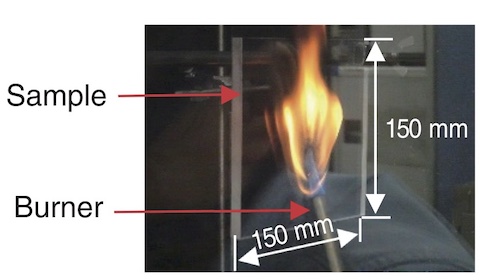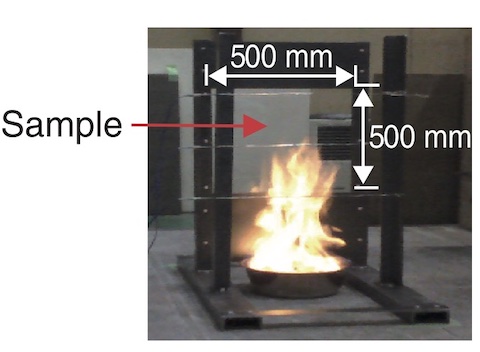
Fig.8-12 Schematic of fire-retardant measures

Fig.8-13 Flammability test equivalent to the UL94 standard 5V

Fig.8-14 Forced combustion test

Fig.8-15 Fire test
The Plutonium Fuel Production Facility (PFPF) produces mixed oxide (MOX) fuel for fast reactors and contains many large glove boxes (GBs) for handling plutonium. Acrylic (AC) resin (flammable) is used for the window panels that constitute the GB, after confirming its safety through past fire tests. However, from the perspective of preventing the spread of fire in the event of a fire in the process room, direct fire prevention was an issue. In the PFPF, fire-retardant polycarbonate (PC) resin is to be used for the panels of GBs to be newly installed after the new regulatory requirements took effect (December 2013). However, replacing the AC panels of the existing GBs (approx. 2300 panels) with fire-retardant PC panels is impractical in terms of contamination risk, cost, and work period. Therefore, we developed a fireproof sheet made of PC that does not deteriorate under radiation, is effectively prevents fire damage, and can be attached to existing AC panels, as shown in Fig.8-12.
During the development and testing of the developed method, we conducted flammability tests and usage environmental (gamma rays, ultraviolet rays) influence tests to confirm its feasibility. The samples are 10 mm thick AC plate (as same as existing GBs) with fireproof sheet (this sample) and 10 mm thick PC plate for the purpose of comparison. For this sheet, we selected a transparent PC fire-retardant sheet (0.38 mm thick) with V-0 rating that is the highest fire-retardant in the U.S. UL94 standard, which is widely used for flammability testing of polymer materials. In addition, a special adhesive agent was used to make it easier to attach on the AC panel and remove for replacement.
Following the guidelines set by equivalent to the UL94 standard 5V during flammability testing, each sample was fixed horizontally, and flames were intermittently applied from below with a burner five times for 5 s each, as shown in Fig.8-13. By applying the proposed fire-retardant sheet, the AC panel self-extinguished within the same amount of time as the PC plate. We also performed forced combustion tests and fire tests, as shown in Figs.8-14 and 8-15. During forced combustion tests, the sample was fixed vertically and continuously exposed to a burner under severe conditions similar to the actual installation of a window panel; during fire tests, 1.5 kg of 62wt% ethanol (equivalent to the total calorific value of 1.5 kg of paper towels) was used to simulate a fire in a process room. In all cases, the results of the proposed system were comparable to those of a single PC plate.
Usage environmental influence tests were then performed to confirm that there were no significant property changes (e.g., in fire retardance or visibility) after 5-60 years of accelerated gamma irradiation from nuclear fuel materials in the GB and 10-20 years of accelerated ultraviolet irradiation from fluorescent lights installed near the window panels.
From the results of these tests, we found that attaching this sheet to the AC panel of the existing GB has self-extinguishing properties equivalent to those of PC plates, and is expected to prevent fire damage, as well as providing the prospect of application in actual radiation environments.
Currently, this sheet has been attached to the window panels of the existing GBs in PFPF and is in operation. This development is expected to be widely applied not only to nuclear facilities but also to every place using AC panels such as GBs in the chemical and pharmaceutical industries, as a fire-retardancy measure and as a surface protection measure.
(Kohei Kawasaki)